Announcing DeepShadow
2018-03-23 18:26
 an assembly to help generate unit test data from Entity Framework
an assembly to help generate unit test data from Entity Framework
NuGet and Source
Introduction
DeepShadow helps solve a specific yet common use case: the developer needs unit test data from complex models, and wishes she could use actual data with some modifications.
What if she could do this?
db.Customers.Take(2).GenerateEntitiesFromList(toConsole: true);
or this?
File.WriteAllText("MockData.txt", db.Customers.Take(2).GenerateEntitiesFromList());
And get something like this?
List<DeepShadowDbContext.Customer> list = new List<DeepShadowDbContext.Customer>();
DeepShadowDbContext.Customer a1 = new DeepShadowDbContext.Customer();
a1.CustomerId = 1;
a1.Name = @"Nicolo Paganini";
a1.Codes = new List<String>();
a1.Codes.Add("A1");
a1.Codes.Add("A2");
a1.Codes.Add("A3");
a1.Orders = new List<DeepShadowDbContext.Order>();
list.Add(a1);
DeepShadowDbContext.Customer a2 = new DeepShadowDbContext.Customer();
a2.CustomerId = 2;
a2.Name = @"Hilary Hahn";
a2.Codes = new List<String>();
a2.Codes.Add("A1");
a2.Codes.Add("A2");
a2.Codes.Add("A3");
a2.Orders = new List<DeepShadowDbContext.Order>();
list.Add(a2);
return list;
The Problem
Here are relatively simple parent-child domain classes. They map to SQL tables, and the application is using Entity Framework.
public class Customer
{
public int CustomerId { get; set; }
public string Name { get; set; }
public List<string> Codes {get;set;}
//Nav
public List<Order> Orders { get; set; } = new List<Order>();
}
public class Order
{
public int OrderId { get; set; }
public int CustomerId { get; set; }
public DateTime OrderedOn { get; set; }
public decimal? Discount { get; set; }
//Nav
public Customer Customer { get; set; }
}
You might need to test a Web API that itself calls a service. The model that comes back from the service includes related classes (i.e. Navigation Properties).
public class CustomersController : ApiController
{
ICustomerService _customerService = null;
public CustomersController(ICustomerService customerSerivce)
{
_customerService = customerService
}
//GET api/customers
public List<CustomerViewModel> Get()
{
//Returns all orders for each customer
List<Customer> customers = _customerService.GetAllCustomers();
List<CustomerViewModel> model = new List<CustomerViewModel>();
foreach (var customer in customers)
{
CustomerViewModel custViewModel = new CustomerViewModel()
{
//transform to the view model
AllCapsName = customer.Name.ToUpper();
CodeList = String.Join(" ", customer.Codes);
Orders = customer.Orders.Select(a => new OrderViewModel()
{
//likewise transform orders to the view model
});
}
model.Add(custViewModel);
}
return Content(model);
}
}
You're not testing the service, but you need to be sure that the Customer/Order properties map correctly to the View Model properties. You don't want to find out in production you set the CustomerViewModel.CodeList property to Customer.Name.
A simplistic unit test might look like this (NOT a working example!):
[TestMethod]
public void TestMethod1()
{
ICustomerService mockService = new MockCustomerService();
mockService.TestCustomers = MockData.CustomersAndOrders;
var controller = new CustomersController(mockService);
var actual = controller.Get();
Assert.AreEqual(mockService.TestCustomers.Count(), actual.Count());
}
The mock service could be as simple as this, if you didn't want to use a mocking framework. Each test can set what customers/orders it wants to use.
public class CustomerSerivce: ICustomerService
{
public List<Customer> TestCustomers {get; set;}
public List<Customer> GetAllCustomers()
{
return TestCustomers;
}
}
So, great, but what about the actual test data? In many cases, it's OK to hand-craft what you need, like this:
Customer customer = new Customer()
{
CustomerId = 1,
Name = "blamo",
Codes = new List<string> {"a","b"},
Orders = new List<Order>()
{
new Order()
{
OrderId = 11,
CustomerId = 1,
OrderedOn = DateTime.Parse("1/1/2001"),
Discount = 10.00m,
Customer = this
}
}
}
But what if you have classes with twenty or thirty properties? And what if those properties have some domain-specific data or formats that need careful testing?
Customer.ID = {820bd7ae-fed3-419f-b778-8a817b45a968}
Customer.Name = Lewellen-Taft-O'Brien Marketing, LLC.
Customer.DiscountMatrix = 15.00|13.25|10.973
etc.
It's both tedious and error-prone to fabricate values like that when excellent test data is right there in the database! And, you already have code in the service to return that data. You just want to generate code to recreate the data in memory.
Enter DeepShadow
With DeepShadow, you can potentially generate your models as simply as this:
//This is an Entity Framework DbContext
MyDb db = new MyDb();
//REQUIRED FOR Mock Data Generation
db.Configuration.ProxyCreationEnabled = false;
//Generate a list of models
db.Customers.Take(5).GenerateEntitiesFromList(toConsole: true);
//Generate from a single entity
db.Customers.First().GenerateEntitiesFromObject(toConsole: true);
The output will look like this:
List<DeepShadowDbContext.Customer> list = new List<DeepShadowDbContext.Customer>();
DeepShadowDbContext.Customer a1 = new DeepShadowDbContext.Customer();
a1.CustomerId = 1;
a1.Name = @"Nicolo Paganini";
a1.Codes = new List<String>();
a1.Codes.Add("A1");
a1.Codes.Add("A2");
a1.Codes.Add("A3");
a1.Orders = new List<DeepShadowDbContext.Order>();
list.Add(a1);
DeepShadowDbContext.Customer a2 = new DeepShadowDbContext.Customer();
a2.CustomerId = 2;
a2.Name = @"Hilary Hahn";
a2.Codes = new List<String>();
a2.Codes.Add("A1");
a2.Codes.Add("A2");
a2.Codes.Add("A3");
a2.Orders = new List<DeepShadowDbContext.Order>();
list.Add(a2);
return list;
You'd put the above in some kind of unit testing MockData class, which is used to set the mock service method's return value.
public static class MockData
{
public static List<Customer> CustomersAndOrders
{
get {
List<DeepShadowDbContext.Customer> list = new List<DeepShadowDbContext.Customer>();
//data
return list;
}
}
}
Masking Data
Often you'll want to retrieve data from your database, but obscure sensitive data. That's easy enough in most cases without any help from DeepShadow.
//This is an Entity Framework DbContext
MyDb db = new MyDb();
//REQUIRED FOR Mock Data Generation
db.Configuration.ProxyCreationEnabled = false;
var employees = db.Employees.Where(a => a.Inactive == true).ToList();
//mask data
foreach (var employee in employees )
{
employee.SSN = "111-22-3456";
employee.DateOfBirth = DateTime.Parse("1/1/2001");
}
//Generate a list of models
employees.GenerateEntitiesFromList(toConsole: true);
Complete Example
I use (and recommend) the registered version of LINQPad for generating the data, though you could also create a console app to do it. The code's almost exactly the same. In this example, I've created a SQL database named DeepShadowSample, and a console application with an Entity Framework DbContext named DeepShadowDb.
Important
If you're using LINQPad, you must have a registered version in order to easily install the NuGet package.
Table Schema and Data
create table Customers
(
CustomerId int not null primary key,
Name varchar(max)
)
create table Codes
(
Id int identity primary key,
Name varchar(max)
)
create table Orders
(
OrderId int not null primary key,
CustomerId int not null foreign key references Customers(CustomerId),
OrderedOn datetime not null,
Discount decimal null
)
insert Customers select 1, 'Nicolo Paganini'
insert Customers select 2, 'Jasha Heifetz'
insert Customers select 3, 'Erica Morini'
insert Customers select 4, 'Hilary Hahn'
insert Orders select 2, 1, '2001-01-01', 10
insert Orders select 3, 2, '2002-01-01', 0
insert Orders select 4, 2, '2002-02-02', 5
insert Orders select 5, 3, '2012-05-23', 0
insert Orders select 6, 3, '2012-05-23 12:00:00.000', NULL
insert Orders select 7, 3, '2012-05-24', 0
insert Orders select 9, 4, '2015-12-12', NULL
insert Orders select 10, 4, '2017-12-15', 3
insert Codes (Name) values ('A1,A2,A3')
insert Codes (Name) values ('B4,B7')
DeepShadowDbContext Console App
using System;
using System.Collections.Generic;
using System.Linq;
using System.Data.Entity;
namespace DeepShadowDbContext
{
class Program
{
static void Main(string[] args)
{
var service = new CustomerService(new DeepShadowDb());
Console.WriteLine(service.GetAllCustomers().Count()); //should return 4
Console.ReadLine();
}
}
public class CustomerService
{
DeepShadowDb _db;
public CustomerService(DeepShadowDb db)
{
_db = db;
}
public List<Customer> GetAllCustomers()
{
var customers = _db.Customers.ToList();
var codes = _db.Codes.First();
foreach (var customer in customers)
{
customer.Codes = codes.Name.Split(',').ToList();
}
return customers;
}
}
public class Customer
{
public int CustomerId { get; set; }
public string Name { get; set; }
public List<string> Codes { get; set; }
//Navigation
public List<Order> Orders { get; set; } = new List<Order>();
}
public class Order
{
public int OrderId { get; set; }
public int CustomerId { get; set; }
public DateTime OrderedOn { get; set; }
public decimal? Discount { get; set; }
//Navigation
public Customer Customer { get; set; }
}
public class Code
{
public int Id { get; set; }
public string Name { get; set; }
}
public class DeepShadowDb : DbContext
{
public DbSet<Customer> Customers { get; set; }
public DbSet<Order> Order { get; set; }
public DbSet<Code> Codes { get; set; }
protected override void OnModelCreating(DbModelBuilder modelBuilder)
{
modelBuilder.Entity<Customer>().Ignore(a => a.Codes);
}
}
}
App.Config
<?xml version="1.0" encoding="utf-8"?>
<configuration>
<configSections>
</configSections>
<startup>
<supportedRuntime version="v4.0" sku=".NETFramework,Version=v4.6.1" />
</startup>
<connectionStrings>
<add name="DeepShadowDb"
connectionString="Server=.\SQLEXPRESS2016;Database=DeepShadowSample;Trusted_Connection=True;"
providerName="System.Data.SqlClient"/>
</connectionStrings>
</configuration>
1. Open LINQPad to a new C# Statements query
2. Add Entity Framework connection
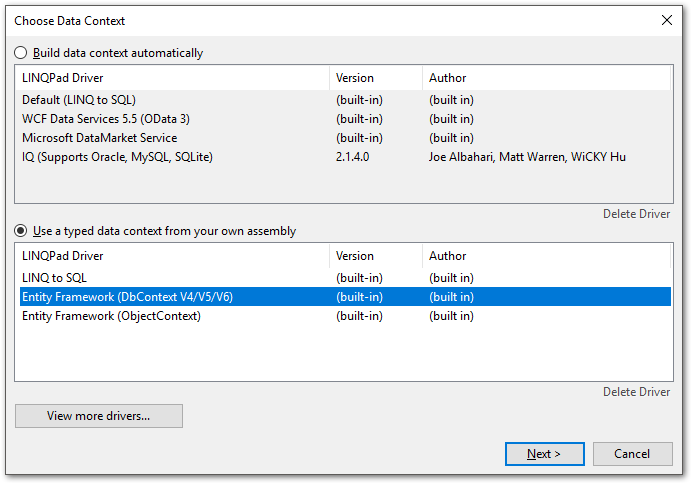
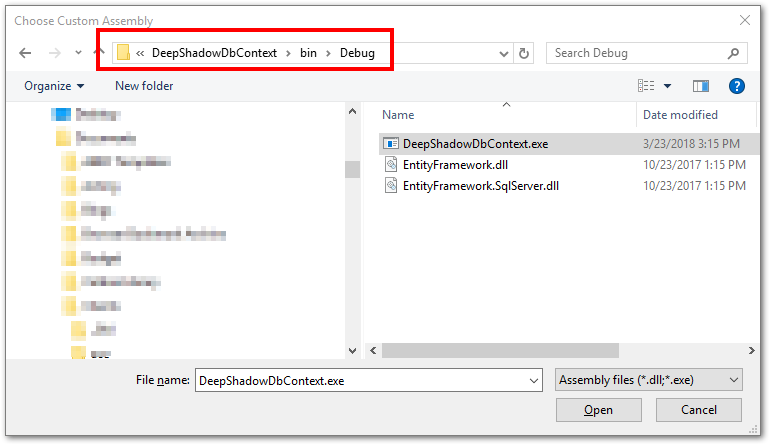
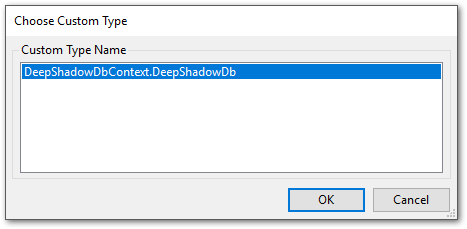
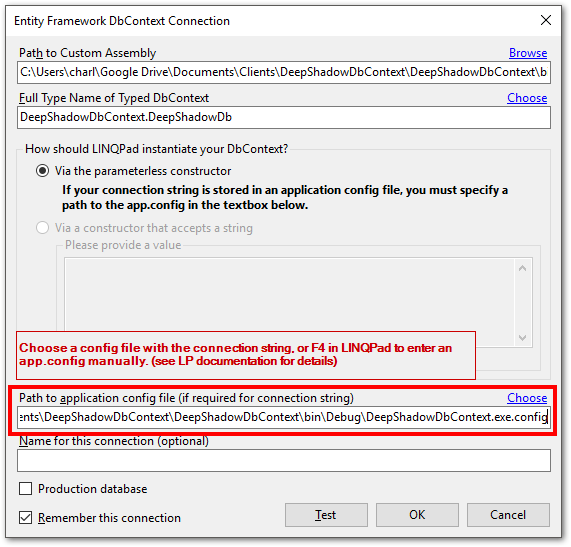
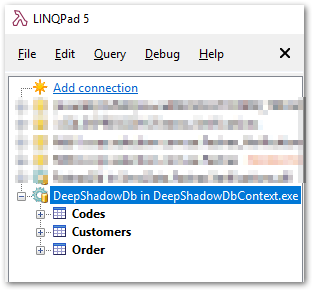
3. Set the query connection

4. Press F4 to open the query settings, and click Add NuGet
5. Search online for DeepShadow, and add to query
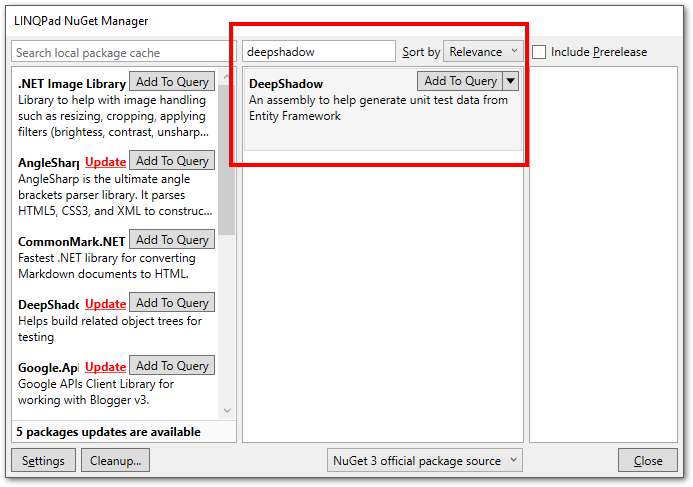
6. In the Query Properties window, Additional Namespace Imports tab, click Pick from assemblies and add the DeepShadow namespace.
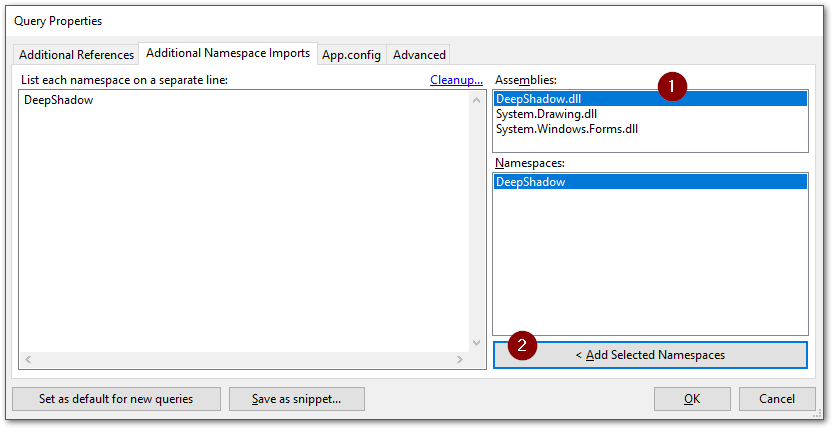
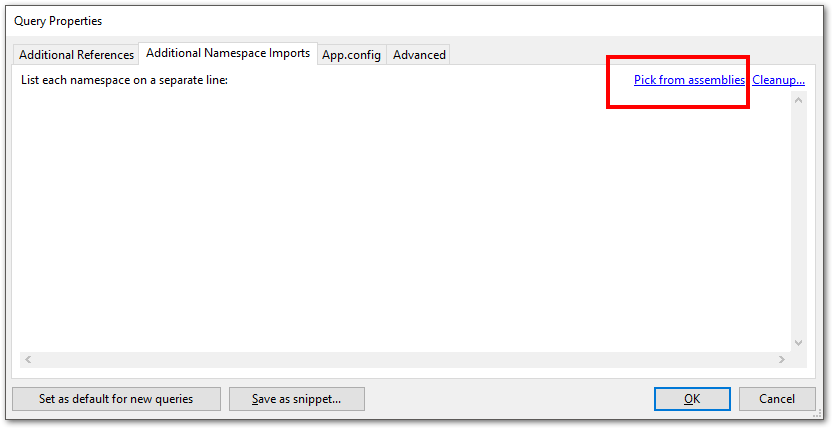
7. In the query window, add this code. Notice how it's essentially copy/paste from CustomerService.GetAllCustomers.
DeepShadowDb _db = this;
//REQUIRED FOR Mock Data Generation
_db.Configuration.ProxyCreationEnabled = false;
//_db.Database.Connection.ConnectionString.Dump();
//////////////////
//This is the code copied from the supposed CustomerService.GetAllCustomers method
//Note that the service does some data manipulation by setting Codes from another table.
var customers = _db.Customers.ToList();
var codes = _db.Codes.First();
foreach (var customer in Customers)
{
customer.Codes = codes.Name.Split(',').ToList();
}
//This generates the code
customers.GenerateEntitiesFromList(toConsole: true);
8. The result
List<DeepShadowDbContext.Customer> list = new List<DeepShadowDbContext.Customer>();
DeepShadowDbContext.Customer a1 = new DeepShadowDbContext.Customer();
a1.CustomerId = 1;
a1.Name = @"Nicolo Paganini";
a1.Codes = new List<String>();
a1.Codes.Add("A1");
a1.Codes.Add("A2");
a1.Codes.Add("A3");
a1.Orders = new List<DeepShadowDbContext.Order>();
list.Add(a1);
DeepShadowDbContext.Customer a2 = new DeepShadowDbContext.Customer();
a2.CustomerId = 2;
a2.Name = @"Jasha Heifetz";
a2.Codes = new List<String>();
a2.Codes.Add("A1");
a2.Codes.Add("A2");
a2.Codes.Add("A3");
a2.Orders = new List<DeepShadowDbContext.Order>();
list.Add(a2);
DeepShadowDbContext.Customer a3 = new DeepShadowDbContext.Customer();
a3.CustomerId = 3;
a3.Name = @"Erica Morini";
a3.Codes = new List<String>();
a3.Codes.Add("A1");
a3.Codes.Add("A2");
a3.Codes.Add("A3");
a3.Orders = new List<DeepShadowDbContext.Order>();
list.Add(a3);
DeepShadowDbContext.Customer a4 = new DeepShadowDbContext.Customer();
a4.CustomerId = 4;
a4.Name = @"Hilary Hahn";
a4.Codes = new List<String>();
a4.Codes.Add("A1");
a4.Codes.Add("A2");
a4.Codes.Add("A3");
a4.Orders = new List<DeepShadowDbContext.Order>();
list.Add(a4);
return list;
